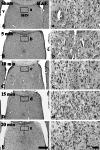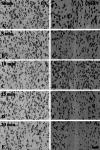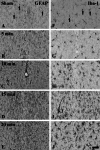Neuronal damage using fluoro-Jade B histofluorescence and gliosis in the gerbil septum submitted to various durations of cerebral ischemia
- PMID: 23893372
- PMCID: PMC11497893
- DOI: 10.1007/s10571-013-9967-y
Neuronal damage using fluoro-Jade B histofluorescence and gliosis in the gerbil septum submitted to various durations of cerebral ischemia
Abstract
The extent of neuronal damage/death in some brain regions is highly correlated to duration time of transient ischemia. In the present study, we carried out neuronal degeneration/death and glial changes in the septum 4 days after 5, 10, 15, and 20 min of transient cerebral ischemia using gerbils. To examine neuronal damage, Fluoro-Jade B (F-J B, a marker for neuronal degeneration) histofluorescence staining was used. F-J B positive ((+)) cells were detected in the septo-hippocampal nucleus (SHN) of the septum only in the 20 min ischemia-group; the mean number of F-J B(+) neurons was 14.9 ± 2.5/400 μm(2) in a section. Gliosis of astrocytes and microglia was examined using anti-glial fibrillary acidic protein (GFAP) and anti-ionized calcium-binding adapter molecule 1 (Iba-1), respectively. In all the ischemia-groups, GFAP- and Iba-1-immunoreactive astrocytes and microglia, respectively, were increased in number, and apparently tended to be increased in their immunoreactivity. Especially, in the 20 min ischemia-group, the number and immunoreactivity of Iba-immunoreactive microglia was highest and strongest in the ischemic SHN 4 days after ischemia-reperfusion. In brief, our findings showed that neuronal damage/death in the SHN occurred and gliosis was apparently increased in the 20 min ischemia-group at 4 days after ischemia-reperfusion.
Conflict of interest statement
The authors have declared that there is no conflict of interest.
Figures





Similar articles
-
Neuronal damage and gliosis in the somatosensory cortex induced by various durations of transient cerebral ischemia in gerbils.Brain Res. 2013 May 13;1510:78-88. doi: 10.1016/j.brainres.2013.03.008. Epub 2013 Mar 23. Brain Res. 2013. PMID: 23528266
-
Neuronal damage using fluoro-jade B histofluorescence and gliosis in the striatum after various durations of transient cerebral ischemia in gerbils.Neurochem Res. 2012 Apr;37(4):826-34. doi: 10.1007/s11064-011-0678-9. Epub 2012 Jan 5. Neurochem Res. 2012. PMID: 22219128
-
Differential regional infarction, neuronal loss and gliosis in the gerbil cerebral hemisphere following 30 min of unilateral common carotid artery occlusion.Metab Brain Dis. 2019 Feb;34(1):223-233. doi: 10.1007/s11011-018-0345-9. Epub 2018 Nov 15. Metab Brain Dis. 2019. PMID: 30443768
-
Influence of the neuronal environment on the pattern of reactive astrocytosis following cerebral ischemia.Prog Brain Res. 1992;94:381-7. doi: 10.1016/s0079-6123(08)61766-5. Prog Brain Res. 1992. PMID: 1363147 Review. No abstract available.
-
Brain injury in a dish: a model for reactive gliosis.Trends Neurosci. 1994 Apr;17(4):138-42. doi: 10.1016/0166-2236(94)90086-8. Trends Neurosci. 1994. PMID: 7517589 Review.
Cited by
-
The significance of calcium ions in cerebral ischemia-reperfusion injury: mechanisms and intervention strategies.Front Mol Biosci. 2025 May 12;12:1585758. doi: 10.3389/fmolb.2025.1585758. eCollection 2025. Front Mol Biosci. 2025. PMID: 40421420 Free PMC article. Review.
-
Accelerated and exacerbated effects of high dietary fat on neuronal damage induced by transient cerebral ischemia in the gerbil septum.Endocrinol Metab (Seoul). 2014 Sep;29(3):328-35. doi: 10.3803/EnM.2014.29.3.328. Epub 2014 Sep 25. Endocrinol Metab (Seoul). 2014. PMID: 25309792 Free PMC article.
-
Comparison of Neuronal Death, Blood-Brain Barrier Leakage and Inflammatory Cytokine Expression in the Hippocampal CA1 Region Following Mild and Severe Transient Forebrain Ischemia in Gerbils.Neurochem Res. 2021 Nov;46(11):2852-2866. doi: 10.1007/s11064-021-03362-6. Epub 2021 May 29. Neurochem Res. 2021. PMID: 34050880
-
Time-course pattern of neuronal loss and gliosis in gerbil hippocampi following mild, severe, or lethal transient global cerebral ischemia.Neural Regen Res. 2019 Aug;14(8):1394-1403. doi: 10.4103/1673-5374.253524. Neural Regen Res. 2019. PMID: 30964065 Free PMC article.
-
Regulation of Microglial Activation by Wnt/β-Catenin Signaling After Global Cerebral Ischemia in Mice.Mol Neurobiol. 2024 Jan;61(1):308-325. doi: 10.1007/s12035-023-03557-8. Epub 2023 Aug 22. Mol Neurobiol. 2024. PMID: 37607993
References
-
- Barron KD (1995) The microglial cell. A historical review. J Neurol Sci 134(Suppl):57–68 - PubMed
-
- Bartus RT, Dean RL, Cavanaugh K, Eveleth D, Carriero DL, Lynch G (1995) Time-related neuronal changes following middle cerebral artery occlusion: implications for therapeutic intervention and the role of calpain. J Cereb Blood Flow Metab 15(6):969–979 - PubMed
-
- Brashear HR, Zaborszky L, Heimer L (1986) Distribution of GABAergic and cholinergic neurons in the rat diagonal band. Neuroscience 17(2):439–451 - PubMed
-
- Buchan AM, Pulsinelli WA (1990) Septo-hippocampal deafferentation protects CA1 neurons against ischemic injury. Brain Res 512(1):7–14 - PubMed
-
- Candelario-Jalil E, Alvarez D, Merino N, Leon OS (2003) Delayed treatment with nimesulide reduces measures of oxidative stress following global ischemic brain injury in gerbils. Neurosci Res 47(2):245–253 - PubMed
Publication types
MeSH terms
Substances
LinkOut - more resources
Full Text Sources
Other Literature Sources
Miscellaneous

